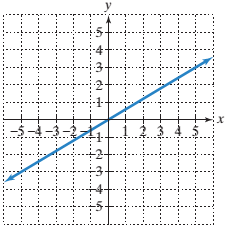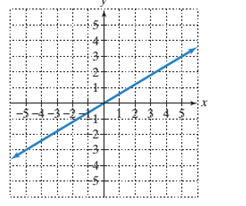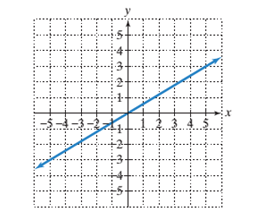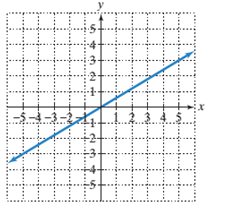
Concept explainers
a)
The x−intercept of the line in the graph.
To calculate the x−intercept and y−intercept from the graph:
To find the x−intercept of a given line on a graph, the point where the line is intersecting the x−axis is the x−intercept and the point where the line is intersecting the y axis is the y−intercept.
To calculate the line’s slope:
Pick two points on the line and determine their coordinates.
Determine rise: the difference in y−coordinates of these two points.
Determine run: the difference in x−coordinates for these two points.
Divide the difference in y−coordinates by the difference in x−coordinates (rise/run or slope).
Given:
Line passing through the origin.

b)
The y−intercept of the line in the graph.
To calculate the x−intercept and y−intercept from the graph:
To find the x−intercept of a given line on a graph, the point where the line is intersecting the x−axis is the x−intercept and the point where the line is intersecting the y axis is the y−intercept.
To calculate the line’s slope:
Pick two points on the line and determine their coordinates.
Determine rise: the difference in y−coordinates of these two points.
Determine run: the difference in x−coordinates for these two points.
Divide the difference in y−coordinates by the difference in x−coordinates (rise/run or slope).
Given:
Line passing through the origin.

c)
The slope of line.

To calculate the x−intercept and y−intercept from the graph:
To find the x−intercept of a given line on a graph, the point where the line is intersecting the x−axis is the x−intercept and the point where the line is intersecting the y axis is the y−intercept.
To calculate the line’s slope:
Pick two points on the line and determine their coordinates.
Determine rise: the difference in y−coordinates of these two points.
Determine run: the difference in x−coordinates for these two points.
Divide the difference in y−coordinates by the difference in x−coordinates (rise/run or slope).
Given:
Line passing through the origin.

Want to see the full answer?
Check out a sample textbook solution
Chapter 3 Solutions
Introductory and Intermediate Algebra for College Students, Books a la Carte Edition PLUS MyLab Math (5th Edition)
- In simplest way, For each quadratic relation, find the zeros and the maximum or minimum. a) y = x 2 + 16 x + 39 b) y = 5 x2 - 50 x - 120arrow_forwardIn simplest terms and step by step Write each quadratic relation in standard form, then fi nd the zeros. y = - 4( x + 6)2 + 36arrow_forwardIn simplest terms and step by step For each quadratic relation, find the zeros and the maximum or minimum. 1) y = - 2 x2 - 28 x + 64 2) y = 6 x2 + 36 x - 42arrow_forward
- Write each relation in standard form a)y = 5(x + 10)2 + 7 b)y = 9(x - 8)2 - 4arrow_forwardIn simplest form and step by step Write the quadratic relation in standard form, then fi nd the zeros. y = 3(x - 1)2 - 147arrow_forwardStep by step instructions The path of a soccer ball can be modelled by the relation h = - 0.1 d 2 + 0.5 d + 0.6, where h is the ball’s height and d is the horizontal distance from the kicker. a) Find the zeros of the relation.arrow_forward
 Algebra and Trigonometry (6th Edition)AlgebraISBN:9780134463216Author:Robert F. BlitzerPublisher:PEARSON
Algebra and Trigonometry (6th Edition)AlgebraISBN:9780134463216Author:Robert F. BlitzerPublisher:PEARSON Contemporary Abstract AlgebraAlgebraISBN:9781305657960Author:Joseph GallianPublisher:Cengage Learning
Contemporary Abstract AlgebraAlgebraISBN:9781305657960Author:Joseph GallianPublisher:Cengage Learning Linear Algebra: A Modern IntroductionAlgebraISBN:9781285463247Author:David PoolePublisher:Cengage Learning
Linear Algebra: A Modern IntroductionAlgebraISBN:9781285463247Author:David PoolePublisher:Cengage Learning Algebra And Trigonometry (11th Edition)AlgebraISBN:9780135163078Author:Michael SullivanPublisher:PEARSON
Algebra And Trigonometry (11th Edition)AlgebraISBN:9780135163078Author:Michael SullivanPublisher:PEARSON Introduction to Linear Algebra, Fifth EditionAlgebraISBN:9780980232776Author:Gilbert StrangPublisher:Wellesley-Cambridge Press
Introduction to Linear Algebra, Fifth EditionAlgebraISBN:9780980232776Author:Gilbert StrangPublisher:Wellesley-Cambridge Press College Algebra (Collegiate Math)AlgebraISBN:9780077836344Author:Julie Miller, Donna GerkenPublisher:McGraw-Hill Education
College Algebra (Collegiate Math)AlgebraISBN:9780077836344Author:Julie Miller, Donna GerkenPublisher:McGraw-Hill Education





